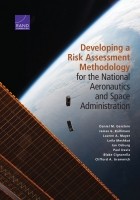| 来源类型 | Research Reports
|
| 规范类型 | 报告
|
| DOI | https://doi.org/10.7249/RR1537
|
| ISBN | 9780833095633
|
| 来源ID | RR-1537-NASA
|
| Developing a Risk Assessment Methodology for the National Aeronautics and Space Administration |
| Daniel M. Gerstein; James G. Kallimani; Lauren A. Mayer; Lelia Meshkat; Jan Osburg; Paul K. Davis; Blake Cignarella; Clifford A. Grammich
|
| 发表日期 | 2016
|
| 出版年 | 2016
|
| 页码 | 112
|
| 语种 | 英语
|
| 结论 |
Seven Key Risk Factors Examined- The risk factors considered were: supply chains, dependency on external sources, acquisition costs and schedules, workforce issues, organizational and managerial considerations (e.g., the issues arising from NASA's distributed management between mission directorates and research centers), domestic and international political situations (e.g., partnership instabilities, congressional equities), and technical issues including information security.
Structured Methodology Provides Benefits Beyond Final Calculations- Considering not only risks but also mitigations at an early stage in the analysis can prompt a structured thinking process that allows for clearer and more-thoughtful decisions.
- The use of a normalization process allows comparison of disparate risk issues that contribute to important decisions. Without such normalization, decisionmakers would be presented with a number of risk factors using different scales (and likely different grading and weighting) with little ability to understand comparisons within or among them or the overall risk burden associated with a decision.
- The result of such an analysis is a graphical representation of normalized relative risks designed to allow for understanding the NASA organizational-level risk associated with its decisions.
Case Studies Validate Suggested Methodology- Each discrete risk assessment requires that the methodology be changed to reflect the particulars of the issue under consideration.
- Two decisions — one past and one future — were considered as a way to test and partially validate the methodology. The previous decision considered was the cancellation of the Space Shuttle program and commercialization of the transportation to the International Space Station, while the future decision focused on Cislunar habitation.
|
| 摘要 |
- Each discrete assessment requires that the methodology be changed to reflect the particulars of the issue under consideration.
- Extensive resources may be required to develop the inputs for this methodology but once inputs are in hand, the significant remaining task is to elicit weights from decisionmakers. Data for each risk factor may be obtained from different experts in each area. Therefore, while resource-intensive, much of the work may occur concurrently.
- Separating the experts from the decisionmakers is imperative for assuring the methodology produces unbiased results. Experts are essential in developing the risk factor component charts; decisionmakers are essential in developing weights. Decisionmakers should approach the methodology without being encumbered by the discussions associated with completing the chart and with the opportunity to synthesize the material and think at a higher level of abstraction about the results. That is, there should be an independent role for the decisionmaker, reflecting a broader pattern of thinking on a risk-informed decision issue.
- The steps developed in the methodology provide a structured way to consider a risk-informed decision. While we were able to conduct abbreviated case studies validating it, conducting a more robust analysis for a future NASA decision is important. Given the work we have begun on it, applying this model to a more expanded analysis of the pending Cislunar habitation decision may be most appropriate. Such work would provide further validation of the methodology and additional insights into the risk (and options) associated with this decision.
|
| 主题 | Decisionmaking
; Program Evaluation
; Threat Assessment
|
| URL | https://www.rand.org/pubs/research_reports/RR1537.html
|
| 来源智库 | RAND Corporation (United States)
|
| 引用统计 |
|
| 资源类型 | 智库出版物
|
| 条目标识符 | http://119.78.100.153/handle/2XGU8XDN/108256
|
推荐引用方式
GB/T 7714 |
Daniel M. Gerstein,James G. Kallimani,Lauren A. Mayer,et al. Developing a Risk Assessment Methodology for the National Aeronautics and Space Administration. 2016.
|
|
文件名:
|
x1495316238250.jpg
|
|
格式:
|
JPEG
|

|
文件名:
|
RAND_RR1537.pdf
|
|
格式:
|
Adobe PDF
|
除非特别说明,本系统中所有内容都受版权保护,并保留所有权利。